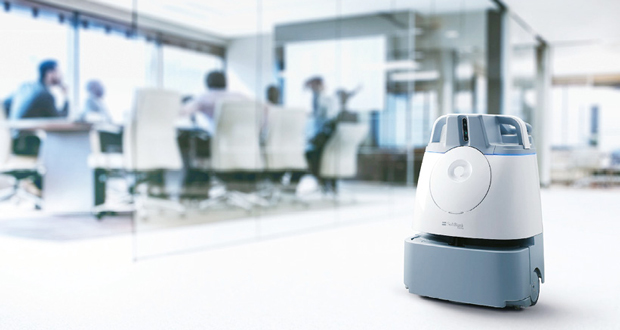 Simon Wisdom, VP of Sales EMEA, SoftBank Robotics EMEA on the innovations in washroom technology that are revolutionising this most forward-facing area of FM
Simon Wisdom, VP of Sales EMEA, SoftBank Robotics EMEA on the innovations in washroom technology that are revolutionising this most forward-facing area of FM
The washroom is a litmus test for the workplace or guest experience. It’s a high-traffic area prone to the build-up of dirt, bacteria and bad odours. Countless surveys show that a dirty washroom will drive customers or guests away. These are small details that make a massive difference.
The challenge for facilities managers is that washrooms – in places such as corporate offices, retail destinations and hotels – are often at the whim of fluctuating foot traffic and unpredictable user habits, making it tricky to operate them using conventional cleaning methods, schedules and performance tracking. In this new era of hybrid working, for example, the end of the five-day office week is forcing facilities managers to dial up or dial down services according to office attendance and use – a busy Tuesday will require washrooms to be cleaned more frequently and thoroughly than on the Friday, when office attendance plummets.
THE OLD WAYS
Historically, cleaning has been characterised by unsophisticated specifications and limited metrics. Traditionally, FM companies have relied on limited metrics such as time and attendance, supervision, experience comparison and perception-based standards to gauge their cleaning effectiveness. This narrow focus has led to a critical oversight: the failure to measure the cleaner’s performance during their work, leading to inefficiencies and time loss but also negating the ability to provide a verifiable proof of clean. Without a detailed understanding of how cleaners perform their tasks, there is no way to identify inefficiencies or areas where time is being wasted.
What’s more, relying on perception-based standards – i.e., the manager’s watchful eye –is prone to human bias or error. And the lack of data makes it nearly impossible to implement demonstrable process improvements.
Input-based contracts, the standard model for cleaning services, measure only what goes into the service, such as the volume of labour used to complete tasks, the amount of time spent, and the quantity of the cleaning supplies. A lack of insight into cleaning performance as it happens denies a verifiable proof of clean and a way to identify inefficiencies. This also means very little consideration is given to the needs and outcomes inherent to each site, which leaves no room to understand the effectiveness of the cleaning service, how it can be improved, and how it could be aligned to a business’s operational or strategic goals.
A DYNAMIC REVOLUTION
That’s changing with the emergence of smart technology, where the combination of IoT sensors and AI can help organisations and their cleaning teams gather comprehensive, targeted data on cleaning activities.
Intentionally placing sensors around the building allows cleaning teams to monitor cleaning activities wherever they take place. These sensors can track various aspects, such as the movement of both cleaners and building occupants, time spent cleaning in different areas, and usage of cleaning resources. This data provides specific insights and identifies patterns, focusing on both the efficiency and the quality of the service.
From here, cleaning teams can work with their technology partners to make recommendations insights derived from the data, including changes in cleaner deployment, improving resource management, and optimising cleaning schedules.
Conventional frequency-based cleaning schedules are inefficient, relying on estimations rather than actual needs, and this increases the likelihood of either under or over-cleaning. Typically, this results in a standard specification, normally specified by the client based on their experience and requirement to create a benchmark. For example, a schedule that includes daily washroom cleans, and 5 x daily floor sweeps, is created so that the cleaning is measured in a quantifiable way. As the usage of a building or environment is not static and the estimation is never accurate, this leads to too much cleaning to reduce risk.
BOOSTING QUALITY
Monitoring factors such as footfall allows teams to focus their efforts on high-traffic areas. This not only improves the overall quality of the service but also boosts job satisfaction for cleaning staff as they can see the tangible impact of their work and make more informed decisions. In a busy shopping centre washroom, for example, footfall will change day to day and even hour to hour. Weekends will be busy. Weekends before Christmas will be even busier. Whatever the situation, sensors can help quantify when the washroom is busiest, allowing cleaning teams to go in more frequently during busy periods. It’s a waste of resources if cleaners are cleaning the washroom when nobody has used it.
The facilities management industry is at a pivotal moment. Companies in the space are experiencing a combination of chronic and acute challenges. The inability to measure performance effectively leaves the service susceptible to budget cuts, while providers are now dealing with an ongoing and significant staffing shortage. But technology, especially in the form of sensors and data analytics, can help in several crucial ways – by supporting understaffed teams, creating a more dynamic service in which providers can find efficiencies at no expense to the quality of the clean, and demonstrate the incredible work that cleaning companies do to keep modern buildings healthy, safe, and comfortable.
A technological revolution is coming, and it is likely to start at the epicentre of the guest experience: the washroom.





